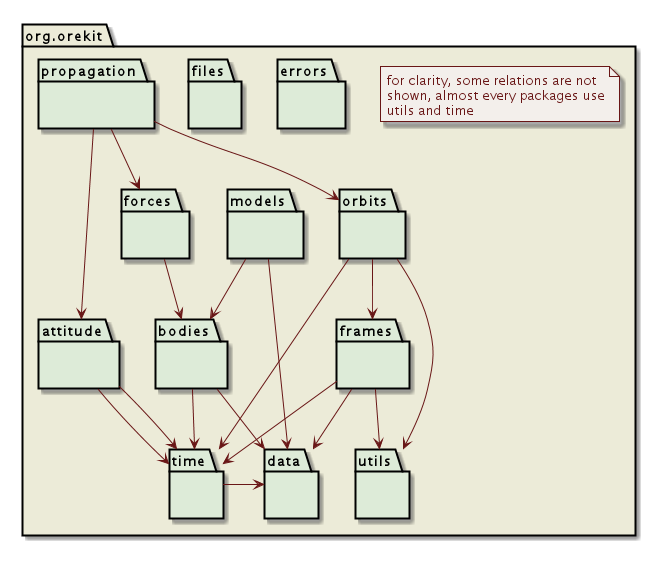Overview
OREKIT (ORbits Extrapolation KIT) is a free low-level space dynamics library written in Java.
It provides basic elements (orbits, dates, attitude, frames ...) and various algorithms to handle them (conversions, analytical and numerical propagation, pointing ...).
Features
- Time
- high accuracy absolute dates
- time scales (TAI, UTC, UT1, GPS, TT, TCG, TDB, TCB, GMST, GST ...)
- transparent handling of leap seconds
- Geometry
- frames hierarchy supporting fixed and time-dependent (or telemetry-dependent) frames
- predefined frames (EME2000/J2000, ICRF, GCRF, ITRF93, ITRF97, ITRF2000, ITRF2005, ITRF2008 and intermediate frames, TOD, MOD, GTOD and TOD frames, Veis, topocentric, tnw and qsw local orbital frames, spacecraft body, Moon, Sun, planets, solar system barycenter, Earth-Moon barycenter)
- user extensible (used operationally in real time with a set of about 60 frames on several spacecraft)
- transparent handling of IERS Earth Orientation Parameters (for both new CIO-based frames following IERS 2010 conventions and old equinox-based frames)
- transparent handling of JPL DE 4xx (405, 406 and more recent) and INPOP ephemerides
- transforms including kinematic combination effects
- composite transforms reduction and caching for efficiency
- extensible central body shapes models (with predefined spherical and ellipsoidic shapes)
- Cartesian and geodesic coordinates, kinematics
- Spacecraft state
- Cartesian, elliptical Keplerian, circular and equinoctial parameters
- Two-Line Elements
- transparent conversion between all parameters
- automatic binding with frames
- attitude state and derivative
- Jacobians
- mass management
- user-defined associated state (for example battery status, or higher order derivatives, or anything else)
- Maneuvers
- analytical models for small maneuvers without propagation
- impulse maneuvers for any propagator type
- continuous maneuvers for numerical propagator type
- Propagation
- analytical propagation models (Kepler, Eckstein-Heschler, SDP4/SGP4 with 2006 corrections)
- numerical propagators
- customizable force models
- central attraction
- gravity models including time-dependent like trends and pulsations (automatic reading of ICGEM (new Eigen models), SHM (old Eigen models), EGM and GRGS gravity field files formats, even compressed)
- atmospheric drag (DTM2000, Jacchia-Bowman 2006, Harris-Priester and simple exponential models), and Marshall solar Activity Future Estimation
- third body attraction (with data for Sun, Moon and all solar systems planets)
- radiation pressure with eclipses
- solid tides, with or without solid pole tide
- ocean tides, with or without ocean pole tide
- multiple maneuvers
- state of the art ODE integrators (adaptive stepsize with error control, continuous output, switching functions, G-stop, step normalization ...)
- computation of Jacobians with respect to orbital parameters and selected force models parameters
- serialization mechanism to store complete results on persistent storage for later use
- semi-analytical propagation model (DSST) with customizable force models
- tabulated ephemerides
- file based
- memory based
- integration based
- unified interface above analytical/numerical/tabulated propagators for easy switch from coarse analysis to fine simulation with one line change
- all propagators can be used in several different modes
- slave mode: propagator is driven by calling application
- master mode: propagator drives application callback functions
- ephemeris generation mode: all intermediate results are stored during propagation and provided back to the application which can navigate at will through them, effectively using the propagated orbit as if it was an analytical model, even if it really is a numerically propagated one, which is ideal for search and iterative algorithms
- handling of discrete events during integration (models changes, G-stop, simple notifications ...)
- predefined discrete events
- eclipse (both umbra and penumbra)
- ascending and descending node crossing
- apogee and perigee crossing
- alignment with some body in the orbital plane (with customizable threshold angle)
- raising/setting with respect to a ground location (with customizable triggering elevation)
- date
- altitude crossing
- target detection in sensor field of view (circular or dihedral)
- impulse maneuvers occurrence
- possibility of slightly shifting events in time (for example to switch from solar pointing mode to something else a few minutes before eclipse entry and reverting to solar pointing mode a few minutes after eclipse exit)
- Attitude
- extensible attitude evolution models
- predefined laws
- central body related attitude (nadir pointing, center pointing, target pointing, yaw compensation, yaw-steering),
- orbit referenced attitudes (LOF aligned, offset on all axes),
- space referenced attitudes (inertial, celestial body-pointed, spin-stabilized)
- tabulated attitudes
- Orbit file handling
- loading of SP3-a and SP3-c orbit files
- Atmosphere models
- tropospheric delay (modified Saastamoinen)
- geomagnetic field (WMM, IGRF)
- Customizable data loading
- loading from local disk
- loading from classpath
- loading from network (even through internet proxies)
- support for zip archives
- support from gzip compressed files
- plugin mechanism to delegate loading to user defined database or data access library
- Localized in several languages
- English
- French
- Galician
- German
- Italian
- Norse
- Spanish
- The top level packages provided by Orekit are the following one:

Free software
Orekit is freely available both in source and binary formats, with all related documentation and tests.
It is distributed under the Apache License Version 2.0. This is a well known business-friendly license. This means anybody can use it to build any application, free or not. There are no strings attached to your own code.
Everybody is encouraged to use Orekit as a common low level layer to improve interoperability in space systems.
Maintained library
Orekit has been in development since 2002 inside CS Systèmes d'Information and is still used and maintained by its space dynamics experts.
Orekit has already been successfully used during the real time monitoring of the rendez-vous phase between the Automated Transfer Vehicle (ATV) and the International Space Station (ISS) by the Centre National d'Études Spatiales (CNES, the French space agency) and European Space Agency (ESA).
Orekit has been selected in early 2011 by CNES to be the basis of its next generation space flight dynamics systems, including operational systems, study systems and mission analysis systems.
It has been used in numerous studies and for operational systems among the world.


